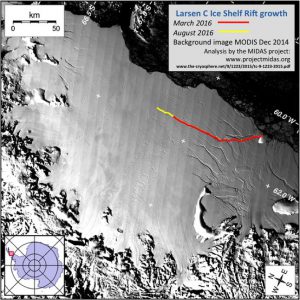While sea ice in Antarctica has seen some increases in recent years (although small compared to the losses of sea ice in the Arctic, which is losing ice at about ten times the rate that Antarctica is gaining it), the Larsen C ice shelf in western Antarctica has seen some troubling trends in recent years. Science Alert noted this week here that a massive crack in the ice shelf has extended an additional 14 miles in length, destabilizing the ice sheet and hastening the separation of an ice berg half the size of Iceland from the main sheet. The total length of the crack is 80 miles. When it breaks off, the rest of the ice sheet could destabilize and potentially put enough water into the ocean to raise sea level by 4 inches. This is in addition to other causes of sea level rise such as warming oceans and melting of land-based glaciers. While this might not seem like much, it would cause the migration of salt marshes along the coast and could affect crab and shrimp fishing as well as crops that are grown in coastal areas.
In separate work, scientists at ARM.gov, a climate research facility of the Department of Energy, are looking at how clouds in the Antarctic affect the energy balance on the ice sheet, which controls how fast the ice melts. You can read more about their project at https://www.arm.gov/news/features/post/36195.
